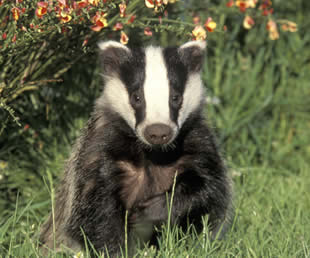News
David Macdonald reports on how British mammals are under the weather
History, so Arnold Toynbee had it, was “just one damn thing after another”, and that’s a bit how conservation feels – as if the Evil Quartet wasn’t bad enough (Jarad Diamond’s list of habitat loss, persecution, invasive species and ecological cascades) most are mostly worsened by climate change. Climate change, or at least stresses caused by variation and extremes in the weather are complicating things for various of the mammals WildCRU studies, from beavers to badgers and, further afield, Ethiopian wolves.
Taking a broad perspective for British mammals, and working with Natural England (the country’s statutory body for conservation), Chris Newman and I today published a Technical Paper, The Implications of Climate Change for UK Mammals, informing the new Living With Environmental Change report card 2015 (PDF 13.2 MB) by NERC, the Natural Environment Research Council. The idea behind our part of the report was to inform government and policy makers about potential climate-related risk-factors to UK mammal species, using likely scenarios to speculate on the question ‘what if’.
Of course, often there simply aren’t the data to offer confident predictions but four interactive consequences of climate change stand out: changes to food availability; thermoregulatory compromise; altered disease exposure / susceptibility and habitat change. For example, changes in primary productivity influence herbivores (deer, rabbits, hares and many rodents), either through absolute changes in food availability, or changes in timing (phenology). Insectivores (shrews, hedgehogs, moles & bats) are vulnerable to invertebrate availability, much affected by the weather. Even versatile omnivorous carnivores, such as badgers and foxes, come under the weather, benefitting when frost-free winter nights give them access to important earthworm prey, but suffering when spring-droughts curtail this food source at a crucial time for juvenile development.
Stresses to their central heating affects small mammals in particular. Some, for example dormice, hedgehogs and bats, dodge the problem by hibernating. This can go wrong if winters become so warm that their metabolic rates cannot remain low enough for efficiency. Warm winters are known to benefit the fecundity and development of red deer, and are associated with better over-winter badger survival, while cold-damp spring conditions cause badger cub mortality and can retard population growth rates in rodents. Climate change is likely to affect the spread of disease among wild mammals, for example by mobile insect vectors (e.g., mosquitoes), as well as altering susceptibility. Conditions of food stress or habitat stress, resulting from climate change, may ‘tip the balance’ towards a disease outbreak.
A changing climate is likely to mean changing habitats. Loss of northern coniferous forests would reduce areas suitable for pine martens and red squirrels (where spreading deciduous forest favours invasive greys). Wet conditions, creating more Scottish peat-bog areas, would further limit suitable wildcat habitat. Unintended consequences are rife: warm winters tempt badgers to forage further and expose themselves to a higher risk of road traffic accidents.
Overall, we conclude that a changing climate could plausibly affect British mammals in many ways, but for the most part other threats are more pressing – a finding that chimes with our results for other species from beavers in Norway to Ethiopian wolves.
But when it comes to detail, WildCRU doctoral student Mike Noonan and WildCRU “Panther” (diploma student) Abidur Rahman worked with us to reveal how the weather may be making badgers harder to count, thereby risking “verisimilitude” – a beautiful word, but a very bad thing. By influencing behaviour, weather patterns prior to and during monitoring sessions change the number of animals observed, and thus affect population estimates. In the case of badgers, weather changes their willingness to walk into cage-traps in pursuit of peanuts, and these effects on trappability can generate a four-fold difference in population estimates, regardless of the effort put into the operation. Further, when in good condition, fewer badgers were caught, but when thin and hungry (due to bad weather for foraging) they more willingly enter traps, thereby affecting their apparent numbers in the census.
The WildCRU study sheds light on how the weather may have affected the recent failure of badger culling initiatives, undertaken by the UK government, to alleviate the spread of bovine tuberculosis in cattle. In 2013, even after a licence extension into late autumn (against which I raised doubt, projected targets of 70% removal were not met. Eventually culling operations were suspended due to ‘bad weather’ and resultant low culling rate. Furthermore, in 2014, of the 316-435 badgers targeted in Somerset, just 341 were culled; worse just 174 of the targeted 615-1091 were culled in Gloucestershire. Our analysis demonstrates that the 2014 culling was undertaken under worse than average weather conditions (i.e., colder, and with rainfall exceeding autumnal means), which may have impaired trapping success yielding fewer individuals than would have been achieved under more optimal weather conditions. Had a run of helpful weather (warmer and with less rainfall) raised trappability the Somerset cull could have got close to its upper quota target – though even with the weather on its side, trap success in Gloucestershire would still have been miles from minimum quota targets. A wider lesson is that snap-shot research projects, even if repeated on a schedule, often do not include sufficient inter-annual weather variation to fully resolve behavioural responses for longer-lived mammals. As a result, they often end up relying upon ‘educated guesses’ about plausible climatic effects. It is important to know how weather conditions could be affecting the behaviour of the target animals and consequently altering trap (or other counting) success, else ‘verisimilitude’ ~ the flawed appearance of being true or real ~ is a risk.






